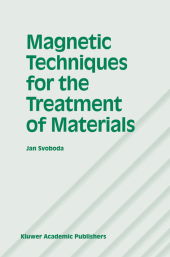 Neuerscheinungen 2010Stand: 2020-01-07 |
Schnellsuche
ISBN/Stichwort/Autor
|
Herderstraße 10
10625 Berlin
Tel.: 030 315 714 16
Fax 030 315 714 14
info@buchspektrum.de |

Jan Svoboda
Magnetic Techniques for the Treatment of Materials
Softcover reprint of the original 1st ed. 2004. 2010. xii, 642 S. 366 SW-Abb.,. 235 mm
Verlag/Jahr: SPRINGER NETHERLANDS 2010
ISBN: 9048165776 (9048165776)
Neue ISBN: 978-9048165773 (9789048165773)
Preis und Lieferzeit: Bitte klicken
In the years following the publication of Magnetic Methods for the Treatment of Minerals by Elsevier in 1987, many changes have taken place in magnetic technology. While fundamental and thorough, the above treatise re?ected pr- erences and philosophy of research and the development and application of magnetic methods as they were practiced in the second half of the last c- tury. Although demand for metals and minerals has not diminished, the d- inant drivers of the early 21st century di er signi?cantly from those of the late 20th. The priorities of nuclear power, defence, and energy-demanding and waste-generating bene?ciation of mineral resources are being replaced by those associated with technology sustainability, environmental and knowledge m- agement, recycling, and health care. Research priorities and product devel- ment of the last century cannot, therefore, satisfactorily meet criteria of the 21st century. Considerable technological progress has been achieved in areas such as - tomation, computerization, sustainable material science, laboratory and plant practices and separation equipment. New permanent magnetic materials, - vances in practical applications of superconductivity and availability of soph- ticated modelling tools have changed the technological landscape. As a result, innovation and technology transfer in magnetic technology have been rema- ably successful during the last two decades. The title of this monograph re?ects the fact that the book covers not only the application of magnetic techniques in the minerals industry, but also in recycling, environmental engineering and biomedical sciences.
Preface. 1: Principles of Magnetic Treatment. 1.1. Magnetic separation and innovation. 1.2. Principle of magnetic separation. 1.3. Fundamental quantities of magnetism. 1.4. Magnetic properties of materials. 1.5. Magnetic properties of minerals. 1.6. Measurement of magnetic properties. 1.7. Sources of magnetic field. 2: Review of Magnetic Separators. 2.1. Dry low-intensity magnetic separators. 2.2. Wet low-intensity drum magnetic separators. 2.3. Dry high-intensity magnetic separators. 2.4. Wet high-intensity magnetic separators. 2.5. Superconduction magnetic separators. 2.6. Laboratory magnetic separators. 2.7. Eddy-current separators. 2.8. Separators with magnetic fluids. 3: Theory of Magnetic Separation. 3.1. The forces and the equations of particle motion. 3.2. Particle motion in drum and roll separators. 3.3. Separation of particles by a suspended magnet. 3.4. High gradient magnetic separation. 3.5. Linear open gradient magnetic separation. 3.6. Magnetic flocculation. 3.7. Magnetic separation by particle rotation. 3.8. Separation in magnetic fluids. 3.9.Eddy-current separation. 4: Design of Magnetic Separators. 4.1. Introduction. 4.2. Design of circuits with permanent magnets. 4.3. Design of iron-core electromagnets. 4.4. Design of solenoid magnets. 4.5. Design of drum magnetic separators. 4.6. Design of a magnetic roll. 4.7. Design of a ferrohydrostatic separator. 5: Practical Aspects of Magnetic Methods. 5.1. Selection of magnetic separation technique. 5.2. Dry magnetic separation. 5.3. Wet magnetic separation. 5.4. Magnetic flocculation. 5.5. Demagnetization. 5.6. Separation in magnetic fluids. 5.7. Magnetism in other areas of material handling. 6: Industrial Applications. 6.1. Treatment of minerals. 6.2. Nuclear industry. 6.3. Waste water treatment. 6.4. Magnetic carrier techniques. 6.5. Magnetic carriers and separation in biosciences. 6.6. Recovery of metals from wastes. 6.7. The applications of ferrohydrostatic separation. 7: Innovation and Future Trends. 7.1. Introduction. 7.2. Science and technological innovation. 7.3. Magnetic separation and innovation. 7.4. The current status of magnetic separation technology. 7.5. What the future holds. 7.6. Research and development needs. List of Symbols. Bibliography. Index.


